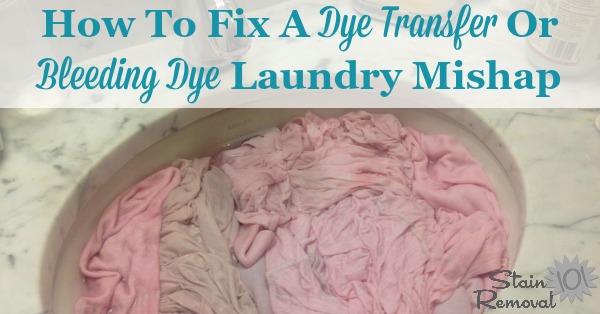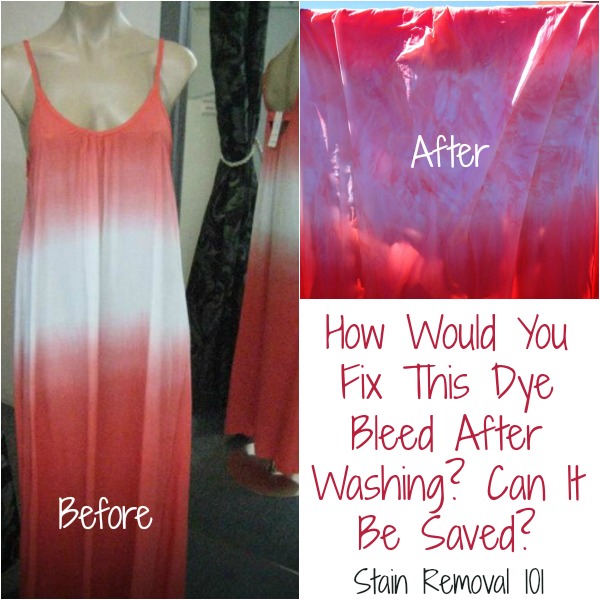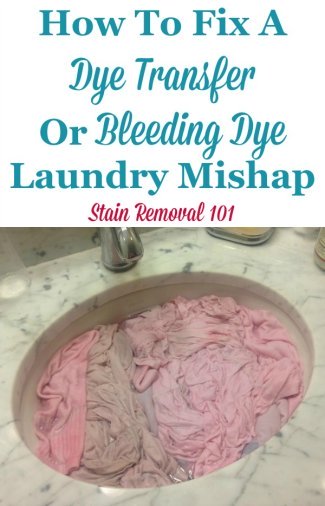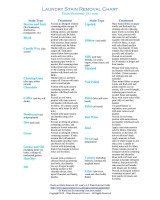How To Fix A Dye Transfer
Or Bleeding Dye Laundry Mishap
If you've ever washed a red sock with white clothes you've seen the result of dye transfer or bleeding dye on your laundry when everything turned pink. Here are tips for how to fix it, and prevent color runs from happening again.

How To Fix Bleeding Dye Laundry Mishaps Once They Occur
If you wash some items together in the washing machine, or lay a wet piece of fabric on something else, and you see a transfer of dye from one piece of fabric to another, the first rule to remember is, do not dry the fabric in the dryer.
The heat from the dryer may set the dye, making the transfer permanent, so let the item air dry if you don't have time to deal with it right away.
Once you are ready to deal with the problem, what you do next depends on whether the article that had the color run onto it was white, or another color.
What To Do When Color Has Run Onto White Fabric
It seems that color runs onto white fabrics more than onto colored fabrics. This is somewhat of an illusion, since the dye transfer is generally about the same, it is just that you notice it a whole lot more with white cloth because there's no other dye to hide the bleeding.
Fortunately, there are a couple of products designed specifically to remove dye or color runs from white fabric. They are called by a variety of names such as dye remover, color remover, or color run remover.
I've collected color remover reviews here, for various products they've used when readers have experienced this problem (on either white or colored fabrics), sharing how various products worked for them.

The products that are the most well known, and that I recommend for use on white clothes are Rit Color Remover and Carbona Color Run Remover (see below for where you can purchase these online).
Color Remover {Referral Links}
Both of these products are designed to be used only with white fabric, since they both strip away not only any colors that have run, but also any dyes already in the fabric.
If you don't want to buy a product to try to remove this dye run, you can also try some of the techniques I suggest below for colored fabrics on your white fabrics.
What To Do When Dye Has Transferred Onto Colored Fabric
It is much more difficult to remove bleeding dye from colored fabric, since there are not really any products designed to help with this problem.
Fortunately, if the dye bled in the first place it will often lift off the item it transferred to also, sometimes on its own with a couple more washes, typically in really hot water with a strong laundry detergent.
If you feel like it may bleed more during the process of trying to wash out the original transferred dye some people have had good luck with using a color catcher while washing in this way to catch the dye that bleeds before it redeposits onto the fabric again (here's an example if you're interested).
Another option to try is a presoak in an oxygen or color safe bleach, perhaps overnight.
If that doesn't work you can do a quick soak in chlorine bleach (click the link to read the article for more details, including the correct dilution of the bleach to water ratio). However, you shouldn't soak for more than 15-20 minutes, since bleach can be tough on fabric.
Further, you should only soak colored items in chlorine bleach after testing for colorfastness (click the link for instructions on how to do this when using chlorine bleach), otherwise you may again bleach away all the color on the fabric, not just of the dye that bled.

Tips For Preventing Dye Transfer And Bleeding Dye For The Future

Of course, it's better to prevent dye transfer from happening than to have to fix it afterward.
Therefore, here are my tips for how to keep your clothes the proper color while washing them, so you don't have to resort to removing dye from the now off-color garment.
Prevention Tip 1: Read Fabric Care Labels
When a manufacturer has used dyes that are likely to bleed they are required to warn you on the care label to wash such items separately from others.
Therefore, if you see labels that indicate an item isn't colorfast, such as with terms such as "wash separately" or "wash with like colors" then make sure you follow the instructions. After all, dye cannot transfer from one fabric to something else if you don't wash the items together.
Prevention Tip 2: Keep In Mind The Types Of Fabrics Known For Dye Transfer
As you wash clothes, always keep in the back of your mind that certain types of fabric tend to be known for dye transfer and should be laundered with care.
For example, the first couple times you wash towels, especially those with bright or dark colors, you should wash them separately from other fabrics so they can bleed off any excess dye. After a few washes quality towels will not transfer or bleed any more dye.
Blue jeans are also known for their fading colors, which are actually typically desired. That is why many blue jeans are dyed with indigo since with time it does fade, giving a faded look. The flip side to this is that you should not wash jeans, especially in the first few washes, with anything lighter in color where the dye can transfer to other fabrics.
Finally, I have personally noticed that many swimsuits tend to bleed colors. I'm not sure if these types of fabrics just don't hold dye well, or what, but I've had more dye transfer incidents with wet swimsuits laying on a towel or other items than anything else.
Prevention Tip 3: Sort Your Laundry Properly
My third tip to prevent bleeding colors is to properly sort your laundry.
If you'd like some additional guidance for how to do this, click here to read my article on how to sort laundry.

Definitions And Terms To Know
Finally, here are some terms and definitions that are useful for you to known when discussing this or color or dyes running or bleeding.
"Bleeding" - when dye in a fabric is removed, typically while in the wash or otherwise wet, and then the dye redeposits onto another item of clothing.
"Crock" - fabric transfers color to another surface when rubbed against it.
"Frost" - when fabric shows areas where the color has been rubbed off by abrasion.
Hope these instructions help you know what to do to both prevent a dye transfer from occurring, or how to fix bleeding colors if it accidentally does happen while doing your laundry.
Top photo courtesy of a reader, Melissa
Thanks For Visiting My Website: Grab Your Free Gift!

Hi, I'm Taylor, a busy mom with 3 kids, so I have lots of hands on experience with house cleaning, laundry and my fair share of spots, spills and other messy catastrophes. Thanks for visiting my site.
I update the website all the time with tips, tutorials, cleaning recipes, reviews of products from readers like you, and tests I've done on various cleaners, removers and laundry supplies.
I'd love to give you a gift! When you subscribe to my free weekly newsletter you will receive a free printable laundry stain removal chart that you can reference as needed.
I hope you enjoy this gift, and stop by again soon!
Related Pages You May Enjoy
Laundry Tips & Tricks For Busy Moms
A-Z Guide: Instructions For Over 100 Types Of Stains
Go From How To Fix A Dye Transfer Or Bleeding Dye Laundry Mishap To Home Page
There are affiliate links on this page, and if you purchase a product through them I receive a small commission. Purchasing through my links costs you nothing extra, but helps support the free information provided on this site and my family. To learn more please see my product review disclosure statement.
CAUTION: This website is provided for informational purposes only. It is provided as is, without warranties or guarantees. Some stains and messes just won't come out, and are permanent. Further, some cleaning methods can harm your item, so if what you want to clean or launder is sentimental or expensive call a professional. See disclaimer of liability for more information.
Popular Laundry How To's
How Often To Wash Everything {With Printable}
Fix Bleeding Dyes Or Dye Transfer
Let's Stay Connected!
Get Free Email Updates
(and get a FREE printable)
Related Pages
 Detergent Reviews & Information
Detergent Reviews & Information
 Visit Household Management 101
Visit Household Management 101
 Visit Home Storage Solutions 101
Visit Home Storage Solutions 101









Share Your Comments, Tips & Ideas